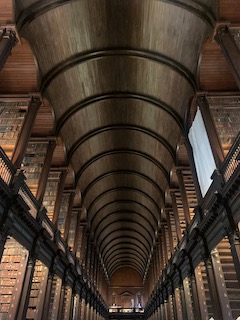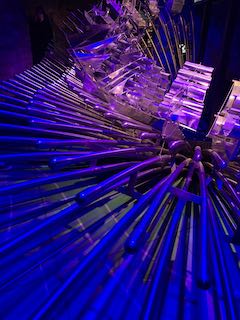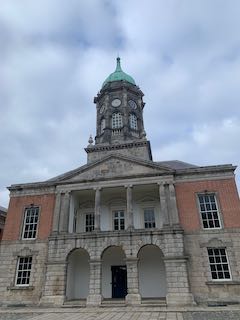In February 2023 I made my first-ever visit to Ireland (followed by a second in October to Northern Ireland – I clearly got the bug). Some might say with an Irish first name and heritage this was sacrilege or at least long overdue. Ireland has always been on my “I should visit…” list, but I have never got around to it. I don’t drink Guinness so wasn’t sure if it would be worth it. Well this trip proved how right I was to challenge this preconception of what there is to do in Dublin.
This trip originated from a minor panic about what to get my wife for Christmas and a well-advertised RyanAir Black Friday Sale. I can safely say it was a well-received present, and we built a packed itinerary that combined culture, history, some excellent food and a lot of walking.
A little history
Dublin can trace its origins back to the Sixth century and in 1170 became the English Capital in Ireland. By the Seventeenth Century it was the second largest city in the British Empire. The 1801 Act of Union removed decision-making powers from the Irish Parliament and moved them to London.
The Irish economy at this time was highly dependent on farming, and when a fungus arrived from England and took hold of the Potato Crop, over 1 million people in Ireland died in what has gone down in history as the ‘Potato Famine’ and many migrated towards Dublin from the countryside in hope of food. Notably, Sir Robert Peel tried to use this as an excuse to repeal the UK Corn Laws but it didn’t help. People in Ireland at the time couldn’t afford corn and corn-based products even with the tariffs removed so it did little to help the famine.
As the twentieth century dawned, Dublin was home to republican activity and cries for Home Rule. It was the site of the six-day Easter Rising in 1916 which saw the destruction of the city and is known as one of the pivotal moments in the fight for Irish Independence.
With a city filled with so much history, how do you decide on what to do in just two days? Look no further…
Friday evening: arrival
We took the last flight of the evening from London Gatwick to Dublin with the aim of having almost two full days to explore the city. Of course, being RyanAir, the flight was late (no fanfare for us on landing).
Transfer logistics: if you’re staying in the City Centre, don’t book a Taxi and definitely don’t wait for one. It is about 60 Euro from the airport to the town centre, and you can queue over 30 minutes for this privilege. The Dublin Express buses leave about every 30 minutes until gone midnight and a return ticket is just 12 Euro per person. The buses are air-conditioned, have WiFi and USB ports. The staff are also incredibly helpful and will let you know which stop is closest to your hotel.
Trip Details
We flew: Ryan Air
We stayed at: Temple Bar Inn
We traveled around Dublin: on foot
Learn from my mistake: if you do book a taxi, chase the booking! Else you will be wandering around arrivals looking a bit lost.
Saturday: exploring Ireland’s heritage

The Long Room Library at the Book of Kells is one of the most well-known in the world.
First stop – the Book of Kells:
Our first cultural excursion was the Book of Kells. This is one of the oldest copies of the four gospels in existence. Nestled in Trinity College, it gives you the opportunity to see the courtyard of the university en route.
The museum around the Book of Kells is small and very crowded: definitely not one if you are claustrophobic. However the detail it goes into around the origin of the gospels, how the book was preserved and other similar treasures that can be found across the world is exemplary.
The library which is included in the tour is one of the oldest in Ireland and is simply magnificent. It was founded to house every book published in Ireland, and is adorned with sculptures of influential writers.
Tickets to the Book of Kells need to be booked in advanced and tickets are timed. Prices are from 18 Euros. Buy tickets direct here. You can buy a tour with Dublin Castle here.*
Second stop – EPIC emigration museum:
About 20 minutes walk from the Book of Kells is the EPIC emigration museum that tells the story of how Ireland has influenced the world.
It looks at why people fled Ireland (either out of choice or through transportation) and many nuances that exist in Irish culture and identity.
In addition to a fascinating museum, the building hosts a lovely range of cafes and places to eat.
Entrance to the EPIC Museum is from 17.50 Euros and whilst it is advisable to book online, it isn’t essential. You can book online here.*

EPIC museum is exceptionally well laid-out with sculptures, light displays and interactive elements.
Third stop – Dublin Castle:

About 40 minutes walk from the EPIC museum is Dublin Castle, a thirteenth-century Viking settlement which is now a key site for the Irish Government and is where the President of Ireland is inaugurated.
There are two ways to see Dublin Castle – through a tour that gives you access to the state apartments or as a self-guided visit where you see a little less, but it’s a bit cheaper and there is a bit more flexibility.
Even the self-guided tour gives you a good insight into the history of Ireland and its fight for independence.
Tickets to Dublin Castle are from 8 Euros and can be bought online or at the venue.
Dinner and drinks – Bow Lane Social Club:
Bow Lane Social Club was a bit of a hidden gem. Not in many of the guidebooks, we discovered it as a result of relentless googling after finding most of the places in TimeOut were fully booked.
Bow Lane Social Club is cool. Probably way too cool for us in all honesty. It’s a restaurant, bar and nightclub. It offers bottomless supper if you’re up for a big night or if like us, these days are behind you, there are tamer options! We were fortunate enough to be there on a night where there was a Carribean Supper Club, complete with rum cocktails. We had the most delicious prawns, fritters and rum punch – spicy, fried and crisp as anything.
We followed this with Gelato from Gino’s which is on almost every street corner in the city centre.

Sunday: finding the hipster hideouts
Like most major cities, Dublin has a hipster culture of craft coffee, street art and fusion brunch spots.
First stop – Copper and Straw Coffee:
Dublin doesn’t really wake up until lunchtime on a Sunday. The morning is still reserved for Church and family. As a tourist, it’s a good opportunity to relax with craft coffee or a pastry like this and plan a walk around the city.
Copper and Straw is a local Irish Coffee chain and its owners take coffee very seriously. The vibe in the Aston Quay branch was relaxed and the pastries were delicious.

Stop two – street art and public parks


One of the most unexpected parts of Dublin was the street art. Scattered in the Temple Bar Region you can find tributes to Ireland’s best-loved icons including Father Ted and Terry Wogan.
We wandered through the lanes, down the iconic Grafton Street (past buskers all hoping to be discovered as the next Bono) to St Stephen’s Green Park. This park is one of the most well-known in the City. It was the site of the 1916 Easter Rebellion and contains tributes to those who died from the famines that have blighted Ireland’s history.
Stop three – lunch at Sprezzatura
Another local chain, Sprezzatura screams hipster as soon as you walk in. The exposed copper pipes serve locally crafted soft and hard drinks and the home-made fresh pasta and sourdough bruschetta options offer a filling and flavoursome lunch or brunch option. I opted for Aubergine topped with egg and served with Sourdough and an orange soda. It was divine, soft and well, everything you want on a Sunday lunchtime. As a very busy venue, booking is essential.

Stop four – the Little Museum of Dublin

A 30-minute guide to the history of Dublin, the Little Museum is located in a converted Georgian house, opposite St Stephen’s Green.
The museum was developed by crowd-sourcing mementos and artifacts from Dubliners. It features a knitted statue of the virgin Mary, advertising from major Irish brands and of course a room dedicated to Dublin’s favourite export, U2 which was opened by the band’s manager and you are guaranteed to leave with ‘the Sweetest Thing’ stuck in your head.
Booking is essential as you need to join a tour to see the house. The guides are wonderful. Prices are from 13 Euros.*
So… what did we miss? What would you recommend I visit next time?
*I only recommend experiences I have enjoyed myself. If you use this link I may earn a small commission at no cost to you.
